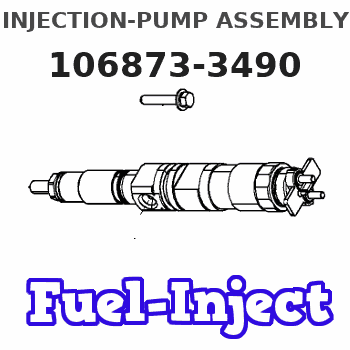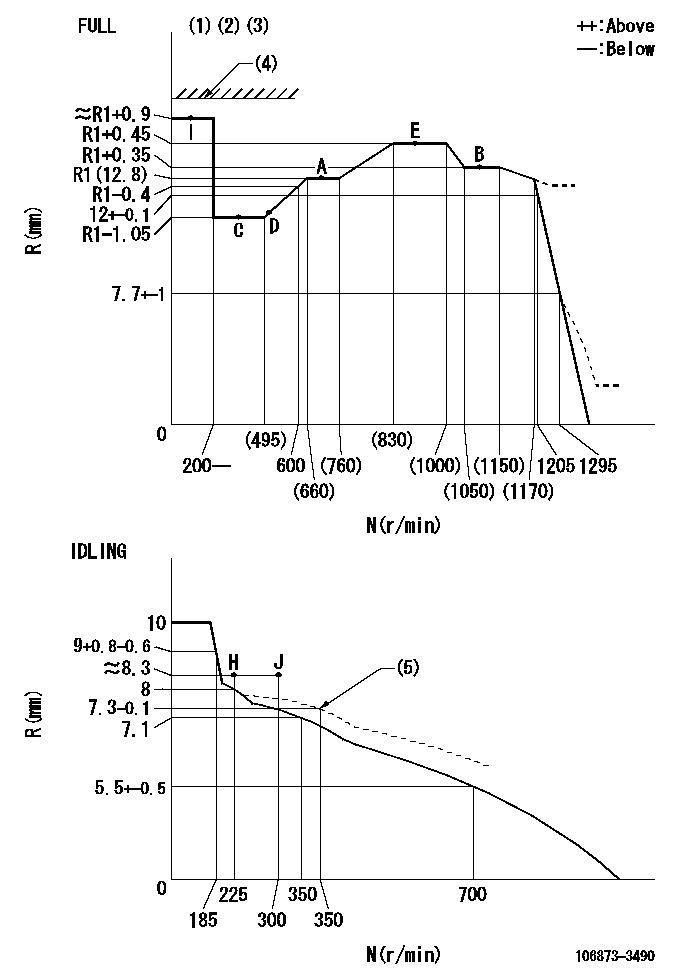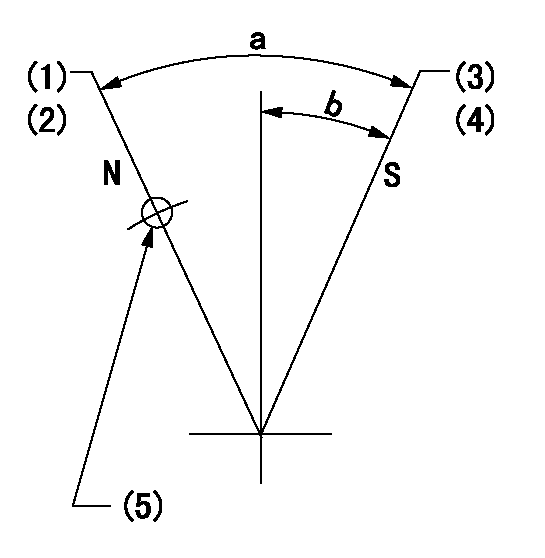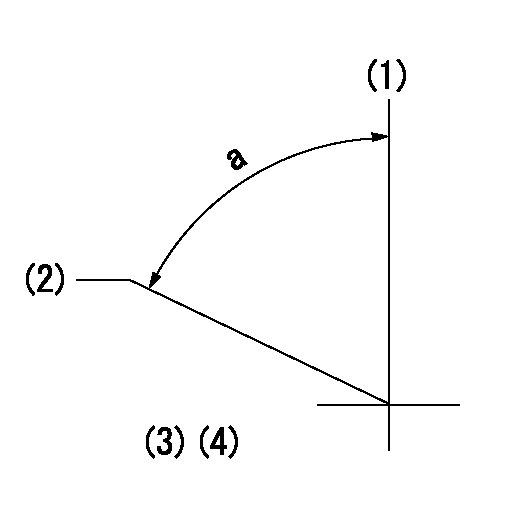Information injection-pump assembly
ZEXEL
106873-3490
1068733490
HINO
220009261A
220009261a

Rating:
Service parts 106873-3490 INJECTION-PUMP ASSEMBLY:
1.
_
7.
COUPLING PLATE
8.
_
9.
_
11.
Nozzle and Holder
23600-2750A
12.
Open Pre:MPa(Kqf/cm2)
14.7{150}/21.6{220}
14.
NOZZLE
Include in #1:
106873-3490
as INJECTION-PUMP ASSEMBLY
Cross reference number
ZEXEL
106873-3490
1068733490
HINO
220009261A
220009261a
Zexel num
Bosch num
Firm num
Name
Calibration Data:
Adjustment conditions
Test oil
1404 Test oil ISO4113 or {SAEJ967d}
1404 Test oil ISO4113 or {SAEJ967d}
Test oil temperature
degC
40
40
45
Nozzle and nozzle holder
105780-8250
Bosch type code
1 688 901 101
Nozzle
105780-0120
Bosch type code
1 688 901 990
Nozzle holder
105780-2190
Opening pressure
MPa
20.7
Opening pressure
kgf/cm2
211
Injection pipe
Outer diameter - inner diameter - length (mm) mm 8-3-600
Outer diameter - inner diameter - length (mm) mm 8-3-600
Overflow valve
134424-4120
Overflow valve opening pressure
kPa
255
221
289
Overflow valve opening pressure
kgf/cm2
2.6
2.25
2.95
Tester oil delivery pressure
kPa
255
255
255
Tester oil delivery pressure
kgf/cm2
2.6
2.6
2.6
Direction of rotation (viewed from drive side)
Right R
Right R
Injection timing adjustment
Direction of rotation (viewed from drive side)
Right R
Right R
Injection order
1-8-6-2-
7-5-4-3
Pre-stroke
mm
4
3.94
4
Beginning of injection position
Drive side NO.1
Drive side NO.1
Difference between angles 1
Cal 1-8 deg. 45 44.75 45.25
Cal 1-8 deg. 45 44.75 45.25
Difference between angles 2
Cal 1-6 deg. 90 89.75 90.25
Cal 1-6 deg. 90 89.75 90.25
Difference between angles 3
Cyl.1-2 deg. 135 134.75 135.25
Cyl.1-2 deg. 135 134.75 135.25
Difference between angles 4
Cal 1-7 deg. 180 179.75 180.25
Cal 1-7 deg. 180 179.75 180.25
Difference between angles 5
Cal 1-5 deg. 225 224.75 225.25
Cal 1-5 deg. 225 224.75 225.25
Difference between angles 6
Cal 1-4 deg. 270 269.75 270.25
Cal 1-4 deg. 270 269.75 270.25
Difference between angles 7
Cal 1-3 deg. 315 314.75 315.25
Cal 1-3 deg. 315 314.75 315.25
Injection quantity adjustment
Adjusting point
-
Rack position
12.8
Pump speed
r/min
700
700
700
Average injection quantity
mm3/st.
137.5
134.5
140.5
Max. variation between cylinders
%
0
-2
2
Basic
*
Fixing the rack
*
Standard for adjustment of the maximum variation between cylinders
*
Injection quantity adjustment_02
Adjusting point
Z
Rack position
8.3+-0.5
Pump speed
r/min
420
420
420
Average injection quantity
mm3/st.
15.9
12.9
18.9
Max. variation between cylinders
%
0
-15
15
Fixing the rack
*
Standard for adjustment of the maximum variation between cylinders
*
Injection quantity adjustment_03
Adjusting point
A
Rack position
R1(12.8)
Pump speed
r/min
700
700
700
Average injection quantity
mm3/st.
137.5
135.5
139.5
Basic
*
Fixing the lever
*
Injection quantity adjustment_04
Adjusting point
B
Rack position
R1+0.35
Pump speed
r/min
1100
1100
1100
Average injection quantity
mm3/st.
124.5
118.5
130.5
Fixing the lever
*
Injection quantity adjustment_05
Adjusting point
C
Rack position
R1-1.05
Pump speed
r/min
330
330
330
Average injection quantity
mm3/st.
135
129
141
Fixing the lever
*
Timer adjustment
Pump speed
r/min
710--
Advance angle
deg.
0
0
0
Load
2/5
Remarks
Start
Start
Timer adjustment_02
Pump speed
r/min
660
Advance angle
deg.
0.3
Load
2/5
Timer adjustment_03
Pump speed
r/min
(760)
Advance angle
deg.
2
1.7
2.3
Load
5/5
Remarks
Measure the actual speed.
Measure the actual speed.
Timer adjustment_04
Pump speed
r/min
900+50
Advance angle
deg.
2
1.7
2.3
Load
4/5
Timer adjustment_05
Pump speed
r/min
1100-50
Advance angle
deg.
5.75
5.45
6.05
Load
5/5
Remarks
Finish
Finish
Test data Ex:
Governor adjustment

N:Pump speed
R:Rack position (mm)
(1)Torque cam stamping: T1
(2)Tolerance for racks not indicated: +-0.05mm.
(3)Set stop lever before governor adjustment. [When setting stop lever after governor adjustment, confirm that point I (Ra) can be obtained at full setting.]
(4)Stop lever's normal position setting: equivalent to RA
(5)Damper spring setting
----------
T1=AD70 Ra=R1+0.9mm RA=17.5mm
----------
----------
T1=AD70 Ra=R1+0.9mm RA=17.5mm
----------
Speed control lever angle

F:Full speed
I:Idle
(1)Use the hole at R = aa
(2)Stopper bolt set position 'H'
----------
aa=94mm
----------
a=15deg+-5deg b=38deg+-3deg
----------
aa=94mm
----------
a=15deg+-5deg b=38deg+-3deg
Stop lever angle

N:Pump normal
S:Stop the pump.
(1)Rack position = aa
(2)Set the stopper screw. (After setting, apply red paint.)
(3)Rack position = bb (speed = cc)
(4)Set the stopper screw. (After setting, apply red paint.)
(5)Use the hole above R = dd
----------
aa=(17.5)mm bb=1.5+-0.3mm cc=0r/min dd=35mm
----------
a=35deg+-5deg b=15deg+-5deg
----------
aa=(17.5)mm bb=1.5+-0.3mm cc=0r/min dd=35mm
----------
a=35deg+-5deg b=15deg+-5deg
Timing setting

(1)Pump vertical direction
(2)Coupling's key groove position at No 1 cylinder's beginning of injection
(3)-
(4)-
----------
----------
a=(80deg)
----------
----------
a=(80deg)
Information:
You must read and understand the warnings and instructions contained in the Safety section of this manual before performing any operation or maintenance procedures.Before proceeding with Every 1000 Hour maintenance, perform all previous maintenance interval requirements.Engine Protection Devices
Inspect for Proper Operation
Refer to the Service Manual for the procedure. All engine protective devices must be checked and maintained to provide the engine with proper protection if a component malfunction or failure should occur. Check all engine protective devices. Never use the Emergency Shutdown controls for a normal stopping procedure.SR4 Generator and Control Panel (If Equipped)
SR4 Generator
Before working inside the generator, make sure that the starting motor can not be activated by any automatic or manual signal.When the engine-generator is operating, voltages up to 600V are present in these areas near or on the regulator: 1. the regulator terminal strip2. the excitation transformer terminal strip (self-excited generator only)Do not short these terminals to ground with any part of the body or any conductive material. Loss of life or injury could result from electrical shock or injury from molten metal.
Electronic components in the regulator can be damaged during generator operation if contact is made between the part and ground.
Clean/Inspect Voltage Regulator
If moisture is allowed to remain in contact with an electrical winding, some of the moisture will eventually be absorbed. This will lower the resistance of the winding insulation. The insulation used on the windings of Caterpillar generators is moisture resistant, but constant exposure to moisture will gradually lower the insulation's resistance.Dirt can make the problem worse because it can hold the moisture in contact with the insulation. Salt (from coastal location sea air) can also make the problem much worse. This is because salt tends to absorb moisture from the air. When the salt and moisture combine, they make a good electrical conductor.* Clean the voltage regulator and generator of dirt and debris. Use a brush to loosen accumulations of dirt and a vacuum system for removal. Use of compressed air is not recommended, because of moisture present in the form of condensate.Carbon tracking on insulators can be caused by dirt or loose connections. These carbon paths must be cleaned or the insulators replaced. Failure to correct a carbon tracking problem will eventually result in a short in the electrical circuit.* Visually check for loose or broken wires and connections. Check the wires and connections on the regulator assembly. Check all wires and connections in the generator. Make any necessary repairs to the wiring as required.Visually inspect the generator and control panel. Check for loose, broken, or damaged wiring or components. The inspection only takes a few minutes and could avert a potential problem that could cause your generator set to fail.Operational Checks
Start the engine. Use the starting procedure found in the SR4 Generators and Control Panels Operation and Maintenance Manual, SEBU6150.The following operational checks include: * generator operation and engine starting* lubricating and fuel systems* overall operationThe checks should take no longer than five minutes to complete. A
Inspect for Proper Operation
Refer to the Service Manual for the procedure. All engine protective devices must be checked and maintained to provide the engine with proper protection if a component malfunction or failure should occur. Check all engine protective devices. Never use the Emergency Shutdown controls for a normal stopping procedure.SR4 Generator and Control Panel (If Equipped)
SR4 Generator
Before working inside the generator, make sure that the starting motor can not be activated by any automatic or manual signal.When the engine-generator is operating, voltages up to 600V are present in these areas near or on the regulator: 1. the regulator terminal strip2. the excitation transformer terminal strip (self-excited generator only)Do not short these terminals to ground with any part of the body or any conductive material. Loss of life or injury could result from electrical shock or injury from molten metal.
Electronic components in the regulator can be damaged during generator operation if contact is made between the part and ground.
Clean/Inspect Voltage Regulator
If moisture is allowed to remain in contact with an electrical winding, some of the moisture will eventually be absorbed. This will lower the resistance of the winding insulation. The insulation used on the windings of Caterpillar generators is moisture resistant, but constant exposure to moisture will gradually lower the insulation's resistance.Dirt can make the problem worse because it can hold the moisture in contact with the insulation. Salt (from coastal location sea air) can also make the problem much worse. This is because salt tends to absorb moisture from the air. When the salt and moisture combine, they make a good electrical conductor.* Clean the voltage regulator and generator of dirt and debris. Use a brush to loosen accumulations of dirt and a vacuum system for removal. Use of compressed air is not recommended, because of moisture present in the form of condensate.Carbon tracking on insulators can be caused by dirt or loose connections. These carbon paths must be cleaned or the insulators replaced. Failure to correct a carbon tracking problem will eventually result in a short in the electrical circuit.* Visually check for loose or broken wires and connections. Check the wires and connections on the regulator assembly. Check all wires and connections in the generator. Make any necessary repairs to the wiring as required.Visually inspect the generator and control panel. Check for loose, broken, or damaged wiring or components. The inspection only takes a few minutes and could avert a potential problem that could cause your generator set to fail.Operational Checks
Start the engine. Use the starting procedure found in the SR4 Generators and Control Panels Operation and Maintenance Manual, SEBU6150.The following operational checks include: * generator operation and engine starting* lubricating and fuel systems* overall operationThe checks should take no longer than five minutes to complete. A